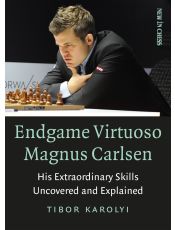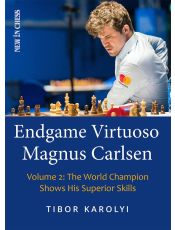
Sadler on Books (2023#6)
This book review by Matthew Sadler was published in New In Chess magazine 2023#6
So let’s see what a modern Rubinstein looks like! Endgame Virtuoso Magnus Carlsen Volume 2 by Tibor Karolyi (New In Chess) picks up the story of Magnus Carlsen’s endgames from where Volume 1 left off, covering endgames played between 2018 and 2022. My goodness! Playing through these endings, I have a comparable feeling of awe as watching the top engines play! The quality of endgame play in this book is off the scale and even more scary when you consider that much of it was displayed in rapid events. Moreover, these endgames were won against elite opponents that are no slouches themselves in this phase of the game.
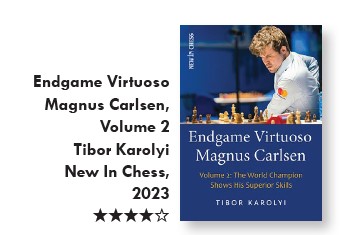 Two things entered my mind while reading the book. Firstly, Magnus won many games smoothly in which at first, second and even third glance I could detect no possible winning plan! Secondly, great nerves are really important for endgame play. From the comfort of your study, it’s natural to assume that grinding a better endgame should be a purely pleasurable sensation: after all, only two results are possible. But that’s not how it feels when actually playing them! Some better endgames (like Magnus’s game as White against Duda at Wijk aan Zee 2019) are unbalanced and I could easily imagine losing them with either colour on a bad day. Moreover, every endgame grind requires moments of precise calculation in the face of stubborn resistance, and such concrete moments often produce positions that look – for a couple of moves at least – as if they could go in any direction.
Two things entered my mind while reading the book. Firstly, Magnus won many games smoothly in which at first, second and even third glance I could detect no possible winning plan! Secondly, great nerves are really important for endgame play. From the comfort of your study, it’s natural to assume that grinding a better endgame should be a purely pleasurable sensation: after all, only two results are possible. But that’s not how it feels when actually playing them! Some better endgames (like Magnus’s game as White against Duda at Wijk aan Zee 2019) are unbalanced and I could easily imagine losing them with either colour on a bad day. Moreover, every endgame grind requires moments of precise calculation in the face of stubborn resistance, and such concrete moments often produce positions that look – for a couple of moves at least – as if they could go in any direction.
The game I’ve picked out struck me because it reminded me strongly of a game between Tarrasch and Marco from Leipzig 1894 which I recently analysed (I’m not sure whether that’s a good thing, but that’s how my mind works!).
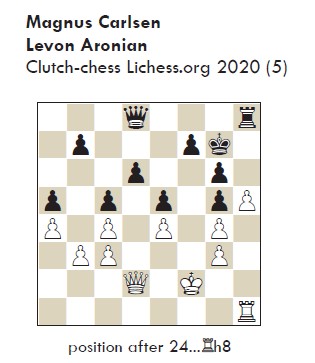 I’m not sure how high my expectations would be of creating anything from this position as White, especially against a player of Levon’s calibre. However, Magnus finds optimal posts for all his pieces and somehow generates the ability to outflank Black.
I’m not sure how high my expectations would be of creating anything from this position as White, especially against a player of Levon’s calibre. However, Magnus finds optimal posts for all his pieces and somehow generates the ability to outflank Black.
25.♔e2 Petrosian-style (or enginestyle depending on your vintage!) Magnus transfers his king to safety of the queenside which grants a little more freedom to undertake play on the kingside.
25...f6 26.♔d1 ♕d7 27.♕e2 b6 28.♕f3 ♖h6 29.♔c2 ♕e6 30.♔b2 ♕d7 31.♔a3 ♕e6 32.♖d1 ♖h8 33.♖d5 ♖d8 34.♖d2 ♖d7
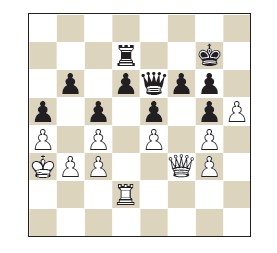 White has three possible avenues to explore:
White has three possible avenues to explore:
1. Pressure against the backward d6-pawn;
2. Invasion along the h-file;
3. A queenside break with b4.
Levon’s last move keeps d6 firmly defended but incautiously cuts the rook’s access to the h-file which Magnus immediately exploits.
35.♖h2 ♖d8
Karolyi points out the only defence after which Black could maintain the balance: 35...♕f7. After Levon’s panicky reaction, the h-file proves decisive.
36.hxg6 ♔xg6 37.♕h1
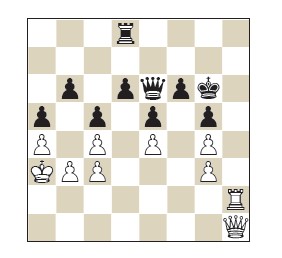 White’s pieces turn out to be perfectly placed for all scenarios!
White’s pieces turn out to be perfectly placed for all scenarios!
37...♕g8 38.♖h6+ ♔f7 39.♕h5+ ♔e6 40.♖g6 ♕f7 41.♕xg5 ♔e7 42.♕f5 ♖g8 43.♖h6 ♖g5 44.♕c8 ♖g8 45.♕c7+ ♔e6 46.♕c6 ♖e8 1-0.
Karolyi’s detailed annotations do an excellent job of explaining the subtleties of Magnus’s play and there’s a brief interview with Peter Heine Nielsen about Magnus’ endgame play at the end as a little bonus. Definitely worth reading for anyone who wants to improve their endgame technique! 4 stars!

